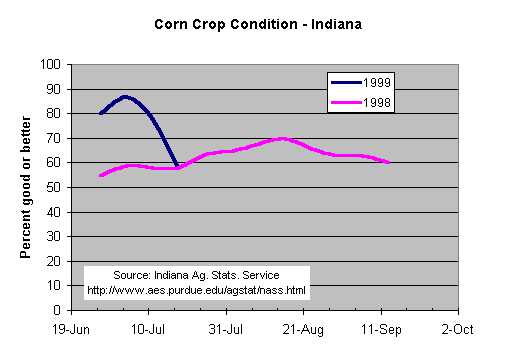Thirsty, But Not Dying of ThirstR.L. (Bob) NielsenAgronomy Department, Purdue University West Lafayette, IN 47907-1150 Internet address: rnielsen@purdue.edu The condition of Indiana’s corn crop continues its recent decline. As of 18 July, 58 percent of the crop was rated as good to excellent (Indiana Crop & Weather Report, 7/19/99) . As recently as the 4th of July, the crop was rated 87 percent good or better. The decline in crop condition since then has been primarily due to continued dry weather, especially in the northcentral and eastern regions of the state. While the decline in crop condition is certainly cause for lively debates down at the Chat ‘n Chew Café, it is important to keep these things in perspective. First of all, the percent of this year’s crop in the good or better categories is essentially identical to the same time period for last year’s crop which ended up with the third largest grain yield ever recorded. Naturally, if the dry weather continues, the crop may continue to deteriorate. Conversely, if we return to timely rains for the remainder of the season, the corn crop will likely still yield quite well.  Secondly, the corn crop’s development is ahead of schedule. As of 18 July, our Indiana Ag. Stats. Service also estimated that 70 percent of the corn crop was silking compared to only 41 percent last year and 24 percent over the past five years. It is always good news to get the critical pollination period behind us, because the corn crop’s sensitivity to moisture deficits declines rapidly throughout the course of the grain fill period. Obviously, excessively dry soils in some areas have caused some damage. Growers can check the success of pollination by checking for silk detachment shortly after pollen shed is complete or by checking for kernel abortion during the blister and milk stages of development. Fields that are candidates for such scouting activities include those whose leaves roll tightly beginning very early in the morning and do not unroll until late evening, whose lower leaves are "firing" or dying from lack of moisture, or whose color turns a dull grayish-green during the heat of the day . Finally, while moisture deficits are causing crop problems in certain areas of the state, the majority of Indiana’s corn crop is NOT facing severe drought stress at this point in time. While I would like to help raise crop prices by joining other fearmongers, I think it is more important to help allay the concerns of growers that major yield damage has been caused by the heat and dry weather in recent weeks. |